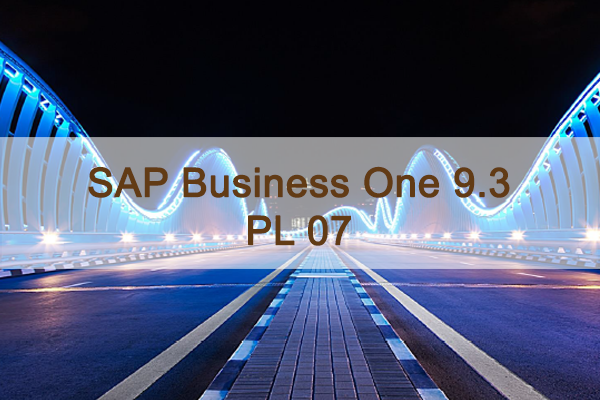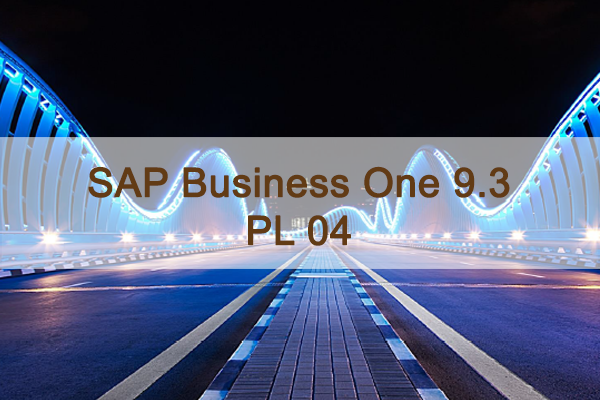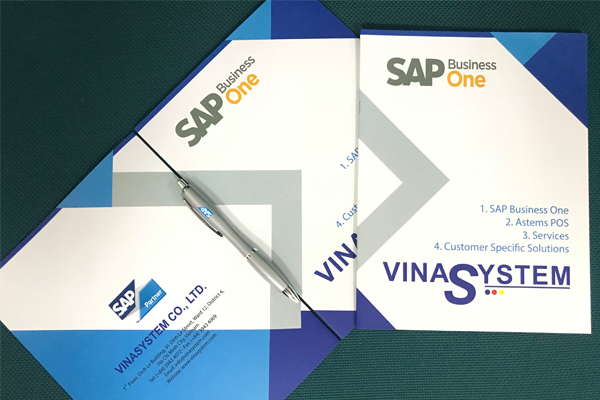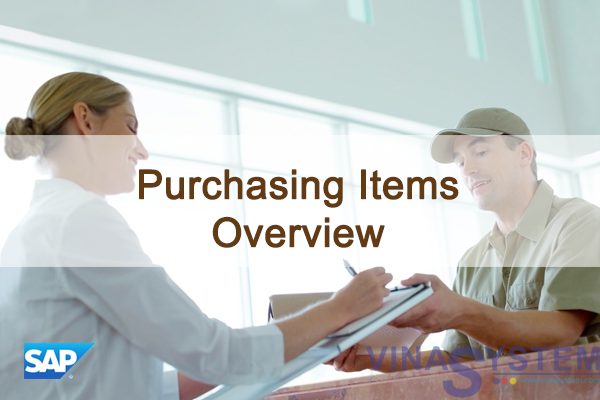
Tài liệu quy trình thu mua trong SAP Business One - Purchasing Items Overview
Welcome to the topic on purchasing items in SAP Business One, we will perform the basic steps for purchasing items. As we go through the process, we will explain the consequences of each process step on inventory and accounting.
I/ Business Scenario
In our business example, we ask you to imagine that your company purchases items for resale. You maintain a minimum inventory level for some of these items, such as printers. When the stock is low on those items, you reorder the items using a procurement process with 4 steps:
- Purchase orders
- Goods Receipt POs
- A/P invoices
- Outgoing payments
II/ Process Overview

Let us look at the process steps in our business example with a concrete example. A minimum inventory of 15 printers is needed to fulfill regular customer orders quickly. When the stock dips too low, purchase orders are used to begin the purchasing process. When the vendor delivers the printers, a goods receipt PO is created. After the items are inspected, an A/P invoice can be created. The A/P invoice triggers an outgoing payment to the vendor.
1/ Purchase Order (PO)

Now let us take a detailed look at the first step in the purchasing process: the purchase order.
A purchase order is a commercial document issued by a buyer to a seller specifying the items or services that the seller will provide the buyer. The purchase order includes the agreed-to quantities and price for the products listed.
How is the information stored in the purchase order used? Normally, when goods are received, purchase orders are matched with packing slips and vendor invoices before the invoices are paid. In SAP Business One, this process is automated: the purchase order can be linked to the goods receipt PO (which shows information from the packing slip), which then can be linked to the A/P invoice (which contains the information from the vendor’s invoice). This automation allows information to be consistent and retained throughout the process. You never have to enter data twice.
When a purchase order is added in SAP Business One, no value-based accounting changes occur. However, the order quantities are listed in inventory management. You can view items and quantities on order in various reports and windows, such as the inventory status report and the Item Master Data window. Obviously, having such real-time access to this information can play a key role in optimizing a company’s purchasing and inventory management business processes.
a) Effect of a Purchase Order

So back to our business example for our purchasing process:
Currently, we have 10 printers in stock
We create a purchase order to buy 5 more from our vendor
After the purchase order is saved, a quantity of five appear on the inventory reports as ordered
Since we have 10 printers in stock and 5 on order, 15 will be available to promise to our customers, although only 10 are physically in stock
b) Addresses in the Purchase Order

Two important addresses are entered in the purchase order, the Ship-to and Pay-to addresses, so it is important to understand how they are used in the purchasing process.
The ship-to address indicates the address where you would like the vendor to ship your purchased items. The ship-to address can default in from two places, depending on your settings.
For item-type purchasing documents, you can set the system to either default in the company address or the address of the warehouse in the first row of the document.
To set the default to be the warehouse address, you need to flag the checkbox “use warehouse address” in Document Settings. If the box is not flagged, the default address will be the company address.
For service rows, no warehouse is selected. Therefore, the company ship-to address will always default into service-type purchasing documents.
The other important address in the purchase order is the pay-to address. The pay to address is displayed under the Logistics tab and defaults from the vendor business partner master data record. Always make sure the pay-to address is the correct one for a given purchase since this information prints on the check when payment is issued.
Of course, addresses can be overwritten inside a purchasing document as needed.
2/ Goods Receipt PO

You create a goods receipt PO when you receive goods from a vendor. In most companies, the person in the warehouse or the office responsible for taking delivery of shipments executes the goods receipt PO. If a Goods Receipt PO is used when purchasing services, the person for whom the services are rendered usually issues the document.
A goods receipt PO can be created directly by selecting the document name in the module menu, or it can be built from an existing purchase order. If you are basing your goods receipt PO on an existing PO, you may copy all the data contained in the PO or use the draw document wizard to select the data to copy from one or more existing Purchase orders. Even if you copy all data from an existing PO you can still adjust quantities and prices—as well as dates, vendor, and item information—before you post (add) the document.
Regardless of how you create your goods receipt PO, there should be no differences between the data in the goods receipt PO and the vendor’s shipping document (packing slip) sent with the items, because the details in the vendor’s document are legally binding. If there are any discrepancies between the base PO data and the vendor’s shipping document, you should resolve them with the vendor before you post your goods receipt PO.
It is essential that the quantities and prices in your goods receipt PO match the vendor’s shipping document. Unlike a purchase order, a goods receipt PO cannot be amended after it has been added to SAP Business One because it triggers both inventory and (when using perpetual inventory) accounting transactions. Your only option for fixing an incorrect goods receipt PO is to cancel the document and create a new goods receipt PO.

Now let us look at the effect of the goods receipt PO in a business case:
- 10 printers are currently in stock
- We ordered 5 more from our vendor
- Our vendor has just delivered 5
- After we enter the goods receipt PO, 15 are in stock
- When our purchase order was created, 5 showed as ordered. Now the ordered quantity has returned to 0.
a) Copy to/ Copy from

Purchasing documents build on each other. Often, a purchase order becomes a goods receipt PO that records the vendor’s delivery and finally an A/P invoice when the vendor’s bill is received.

You can quickly copy a document to the next document in the sequence using the Copy To button. The original document is called a base document; the document you create from it is called a target document. Building one document from another saves time and effort. It also reduces the possibility of errors.
When you use the Copy to function, all items are copied to the new document.
No options are available on how items are copied.
However you can delete items and adjust quantities after copying.

The other method for copying a document is Copy from. The Copy From button allows you to select a base document or documents from which to create a new document. Clicking Copy From starts the draw document wizard.
To use the Copy from function, you open a new document and enter a business partner.
After choosing the Copy from button, you can choose one or multiple documents from a list.
The Draw Document wizard allows you to customize the rows and quantities copied into the target document, as well as select which exchange rate to use.
Regardless of the method you use Copy To or Copy From, when you save a target document that contains all of a base documents items and quantities, the base document will be closed and you will not be able to copy it again to another document.
b) Open Items List

The Opens Items List is an excellent report for monitoring and managing open marketing documents, such as open purchase orders open goods receipt PO’s and so on.
Just choose the type of document you would like to view. You can choose not only open purchasing and sales documents, but also open production orders, inventory transfer requests and inventory counting documents.
This report can be very useful for finding documents for processing. Often the first step in building one document from another is locating the base document you want to use. For example, goods may be delivered to a warehouse and a goods receipt PO needs to be entered. How do you find the relevant purchase order? The open items list can be used for locating documents quickly.
You can then choose the relevant purchase order, for example, and create a goods receipt PO with a single click on the Copy To button. When one document is built from another in this fashion, all the relevant information is copied from the base document to the new document, reducing both data entry time and errors.
c) Effects of the Goods Receipt PO

Once the Goods Receipt PO is added to the system it has the following consequences:
- (1) The purchase order (base document) cannot be changed once the document has been fully copied.
- (2) If you are running perpetual inventory, the goods receipt PO creates a journal entry to increase inventory value.
- (3) The system updates the stock quantity in inventory and the unit cost gets updated based on the purchase price used in the document for items controlled by moving average or FIFO valuation methods.
- (4) Items that have been partially or completely delivered appear in light gray in the purchase order document. When all items are received, the purchase order status changes to Closed.
d) Stock Changes in Purchasing

You can use the report Inventory Status to analyze the inventory situation for one or more selected items.
You can also see the inventory status in the item master on the Inventory Data tab page.
- The In Stock column displays the current stock level of the item.
- The Committed column displays the item stock that is reserved for customers and for internal use. The stock that is reserved for internal use is the quantity of the item for that will be used for a finished product based on the bills of material for existing production orders.
- The Ordered column displays the quantity ordered from external vendors plus the quantity that is being produced and that will enter the warehouse by a certain date.
- The available quantity of an item represents the In Stock quantity - Committed + Ordered.
As you can see in the chart, a purchase order increases the quantity on order and therefore the quantity available to the customer.
When a goods receipt PO is created referencing the purchase order, it increases the quantity in stock and reduces the quantity on order.
As long as an A/P invoice references a goods receipt PO, it will not affect stock levels.
3/ A/P Invoice

An A/P invoice is entered into SAP Business One when you receive an invoice from the vendor. The document will be used to trigger a payment to the vendor.
You can create an A/P invoice new by selecting the document name in the module menu or by basing it on one or more POs or goods receipt POs. If you are basing your A/P invoice on one or more existing purchasing documents, you may copy all the data contained in the base document or use the draw document wizard to select the data to copy from one or more existing POs or goods receipt POs. Even if you copy all data from existing purchasing document(s), you can still adjust quantities and prices—as well as other information—before you post the document.
The posted A/P invoice generates entries in the general ledger and updates the vendor account with the amount owed to the vendor.

Let us return to our business example:
We previously ordered and received 5 printers from our vendor.
Now we receive an invoice from the vendor for the 5 printers.
We enter an A/P invoice to reflect the vendor invoice.
The A/P invoice in SAP Business One becomes the basis for the payment to the vendor.
a) Effects of the A/P Invoice
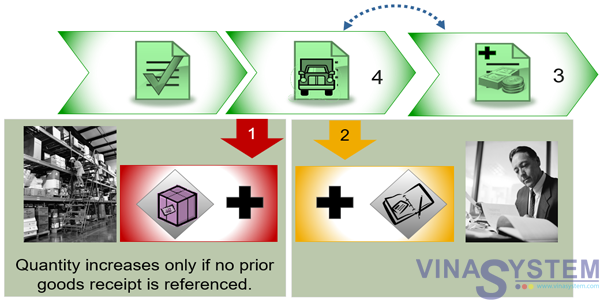
Once the A/P Invoice is created in the system it can have the following consequences:
- (1) The Goods Receipt PO increased the stock value earlier. Only if there is no goods receipt PO are the stock values updated when an A/P invoice is entered.
- (2) The A/P invoice creates a journal entry to update the vendor’s balance to show the amount due.
- (3) You cannot change anything in the A/P invoice that would affect the journal entry once the invoice is added to the system.
- (4) On the goods receipt PO, items that have already been partially or completely invoiced display in light gray. If the invoice is for the full quantity on the goods receipt PO, then the goods receipt PO status changes to Closed.
4/ Payment Processing

After you have entered an A/P invoice, the final step in the Purchasing-A/P process is to trigger the payment to the vendor.
The outgoing payment document can be created for the following payment means: cash, check, credit card, bank transfer or (in some localizations) bill of exchange.
Once the outgoing payment is added, an appropriate journal entry is created. The journal entry reduces the vendor’s balance.
When creating an outgoing payment to fully or partially clear a specific document or transaction, an internal reconciliation automatically takes place.
Multiple outgoing payments can be created together by the Payment Wizard. Payment wizard runs process A/P and A/R documents and transactions that are not fully paid, credited, or reconciled, as well as unreconciled/allocated payments on account.
When creating outgoing payments, either individually or with the Payment Wizard, you can also partially pay invoices.
Payment processing is considered to be part of the Banking Module in SAP Business One.

Let us return to our business case.
We owe our vendor for the 5 printers that we ordered and received.
When we received the vendor’s invoice, we entered an A/P invoice for the amount owed.
Now it is time to create an outgoing payment based on the payment terms for the vendor.
When the payment is entered, the system triggers the payment to the vendor and creates a journal entry to record the payment.
The journal entry reduces cash and decreases the amount that we owe to the vendor.
III/ Purchasing Review

Now that we have finished the first three steps in the procurement process for items, we will review what happens when each document is added.

Purchase Order: When you enter a purchase order, no value-based changes are posted in Accounting. However, the order quantities are listed in inventory management. You can view the ordered quantities in various reports and windows such as the inventory status report and the item master data window.

Goods Receipt Purchase Order: When you enter a goods receipt PO, the goods are accepted into the warehouse and the quantities are updated. If your company runs a perpetual inventory system, SAP Business One creates the relevant postings to update the stock values as well.

Accounts Payable Invoice: When an incoming invoice is posted, the vendor account is updated in Accounting. If a goods receipt PO is not referenced by the A/P invoice, the stocks also increase when the invoice is posted.
IV/ Summary
Here are some key points:
- The purchase order (PO) specifies to the vendor which items or services you want to purchase, including agreed-to quantities and prices. It represents your commitment to the vendor to purchase the items.
- No value-based changes are posted in accounting for a purchase order. However, the order quantities are listed in inventory management. You can view the ordered quantities in reports and the item master data.
- The goods receipt PO denotes the delivery of goods from a vendor to a company. It is used to update the inventory quantities and values.
- When you enter a goods receipt PO the goods are accepted into the warehouse and the quantities are updated. If your company runs a perpetual inventory system, SAP Business one creates the relevant postings to update the stock values.
- The A/P invoice contains the vendor’s invoice information and sets up the payment. When an incoming invoice is posted, the vendor account is updated in Accounting.
- The final step of the purchasing process is the outgoing payment. This function is done in the accounting module.


